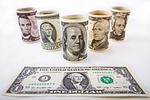The US Still Dominates the World Economy
The US ruling class has dominated the planet since the end of World War II. Key elements of this control include its military superiority in nuclear and conventional weapons, and the stationing of over 900 military bases around the world. In addition, the US presides over the United Nations, the International Monetary Fund (IMF) and the World Bank. It upholds the US dollar as the global currency, and it controls much of the world's resources, particularly oil.
These factors provide the background to why the US can print, or create, billions and trillions of dollars, running up its national debt, now $25 trillion, yet endure little inflation. The reason for this capacity is only tangentially explained by Modern Monetary Theory. It results from the US position as the imperial superpower, which enables it to export inflation.
Back in 1948 George Kennan wrote, "we have about 50% of the world's wealth but only 6.3% of its population. This disparity is particularly great as between ourselves and the peoples of Asia. In this situation, we cannot fail to be the object of envy and resentment. Our real task in the coming period is to devise a pattern of relationships which will permit us to maintain this position of disparity without positive detriment to our national security. To do so, we will have to dispense with all sentimentality and day-dreaming; and our attention will have to be concentrated everywhere on our immediate national objectives. We need not deceive ourselves that we can afford today the luxury of altruism and world-benefaction."
In spite of losing its status as the workshop of the world, the US still enforces this "pattern of relationships" throughout the world. The role of the dollar provides an essential tool. As pointed out in Inadequacy of Modern Monetary Theory (MMT) and the Power of the US Dollar in the World Economy, the dollar is the international reserve currency. Between 50-70% of trade transactions between nations are calculated in dollar terms even though the US accounts for only 11.5% of world trade. Most goods, particularly key ones such as oil and food staples are priced in dollars on the world market. It is the chief currency countries use for their central bank reserves, constituting 61% of the holdings. Of the international debt of the nations of the world, 63% of it must be paid in dollars. Close to all foreign exchange trading 88%, involves some currency's exchange with just one, the dollar. About 70% of nations either directly peg their currency to the dollar, use the dollar as their own currency, or keep their currency in tight trading range relative to the dollar. Contrary to widely held belief, the US grip on the world economy has more adapted than weakened.
Since foreign countries price their imports and exports in dollars and have debts in dollars, they are dependent on the dollar and the value of the dollar. They remain vulnerable to rises in the exchange value of the dollar, as that interferes with their trade and causes the value of their debt burden to grow.
The trillions of US dollars that nations hold make these dollars a captive market for US Treasury bonds. As of April 2020, over 30% of US debt is owed to foreign governments. This percent has slowly trended upwards over time. Since essential commodities are priced in dollars, countries have to accumulate the currency to pay for their imports. The New York Times reported in 2019, "The dollar has in recent years amassed greater stature as the favored repository for global savings, the paramount refuge in times of crisis and the key form of exchange for commodities like oil." This allows the US to run giant deficits and borrow on a vast scale with little constraint.
Why the Dollar is the World Currency
(Note: You can view every article as one long page if you sign up as an Advocate Member, or higher).






